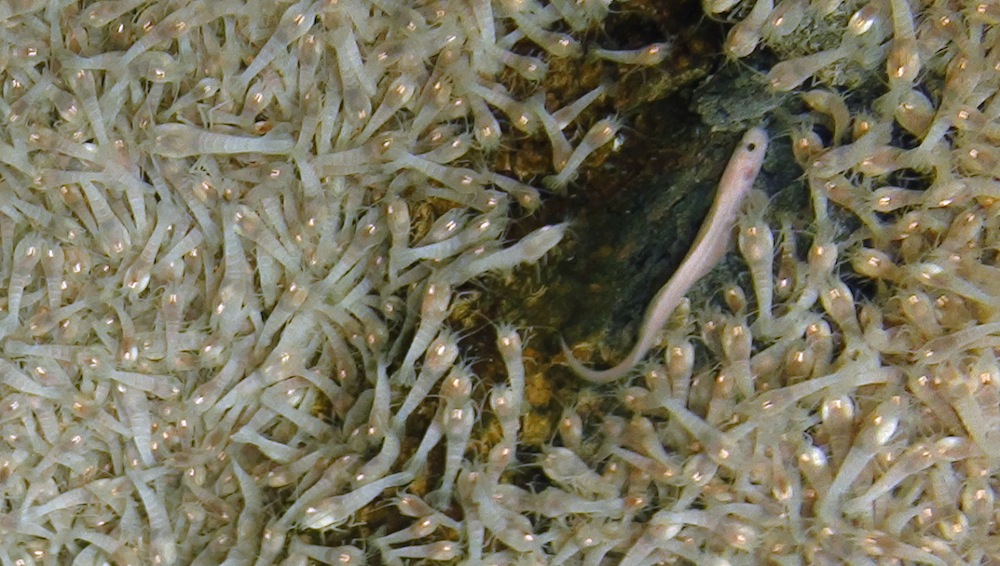Deepest Hydrothermal Vents Teem With Strange Shrimp

Researchers exploring the seafloor south of the Cayman Islands have discovered the world's deepest-known hydrothermal vents, an underwater hotspot teeming with bizarre shrimp with light receptors on their backs.
Neighboring the deep vent field was an even more surprising find: an area of vents high on the slopes of Mount Dent, an undersea mountain far from the magma-rich areas where heated vents are usually found.
"It's somewhere you wouldn't expect to get hot hydrothermal vents," study researcher Jon Copley of the University of Southampton told LiveScience. "It was a real surprise."
That's because Mount Dent is what's known as an oceanic core complex, a chunk of crust "twisted out of the Earth" by the rifting forces that pull Earth's tectonic plates apart, Copley said. Oceanic core complexes are common near mid-ocean ridges where the crust is rifting, he said, so this area may hold an unexplored trove of deep-sea vents. [See images of the new vents]
A double record?
The researchers discovered the two vent fields (which they named Beebe and Von Damm) after surveys of the Mid-Cayman Spreading Center in the Caribbean Ocean turned up chemical hints of hydrothermal water. The Mid-Cayman Spreading Center is a zone where the Earth's crust is pulling apart very slowly, much more gradually than other ocean rift zones.
Exploration with submersible vehicles revealed the Beebe Vent Field, 16,273 feet (4,960 meters) deep, in the rifting zone. The Beebe field is nearly 2,890 feet (880 m) deeper than the previous deepest-known vent on the Mid-Atlantic Ridge. The researchers were not able to measure the temperature of the vents directly, but given that pressure increases with depth, they calculate that the waters may be hotter than 842 degrees Fahrenheit (450 degrees Celsius).
Get the world’s most fascinating discoveries delivered straight to your inbox.
An expedition crew is currently at the vent site with underwater vehicles that can directly measure temperature. The researchers plan to send a submersible to the Beebe vents on Tuesday (Jan. 10).
"If [that temperature] is confirmed by direct measurement in the next few days, not only are they the deepest, but they are the hottest," Copley said.
Deep-sea vents are oases for odd and unusual species, such as the ghostly yeti crabs recently found at deep-sea vents in the Antarctic. The new vents are no exception.
The Beebe vents are crawling with a new species of shrimp. Instead of eyes, these shrimp have a patch of light-sensitive cells on their backs. It's not known why the shrimp evolved this patch, Copley said, but it may help them navigate in the dim light of the vent fields. Along with the shrimp, pale sea anemones line cracks in the ocean floor where warm water seeps out.
The Von Damm vent field, found on the slopes of Mount Dent, reaches 7,546 feet (2,300 m) deep. Masses of shrimp cover these vents as well, Copley said, though the flowerlike anemones are missing. This vent field boasts a new species of snail as well as a new species of flealike amphipod.
Underwater way stations
The species found at the Caribbean vents are more closely related to species found at vents way out on the mid-Atlantic ridge, as opposed to fauna found at closer vents in the Gulf of Mexico. That suggests an ancestral connection between the two areas, Copley and his colleagues reported today (Jan. 10) in the journal Nature Communications.
The discovery of vents far from the magma-rich spreading center may explain a lingering gap in vent biology, Copley said. Genetic studies of vent fauna suggest that their populations are much larger than what has been observed. Vents in unexpected places may harbor some of this "missing" fauna.
"The idea is that there are more way stations, perhaps, between the known vents," Copley said. "That would mean that animals are getting about more easily than we think."
The researchers have future expeditions planned to the Cayman vents, and they hope to learn more about how the vent ecosystems change over time.
The discovery of vents on Mount Dent also highlights the need to get more creative in the search for new vents, Copley said. Oceanic core complexes like Mount Dent are common and largely unexplored for hydrothermal activity, he said.
"If you can get vents on these things, maybe there are more out there," Copley said.
You can follow LiveScience senior writer Stephanie Pappas on Twitter @sipappas. Follow LiveScience for the latest in science news and discoveries on Twitter @livescience and on Facebook.

Stephanie Pappas is a contributing writer for Live Science, covering topics ranging from geoscience to archaeology to the human brain and behavior. She was previously a senior writer for Live Science but is now a freelancer based in Denver, Colorado, and regularly contributes to Scientific American and The Monitor, the monthly magazine of the American Psychological Association. Stephanie received a bachelor's degree in psychology from the University of South Carolina and a graduate certificate in science communication from the University of California, Santa Cruz.
